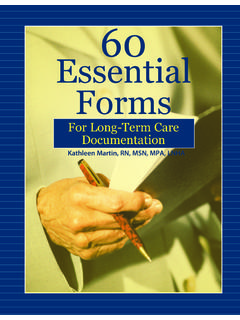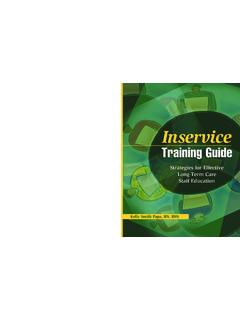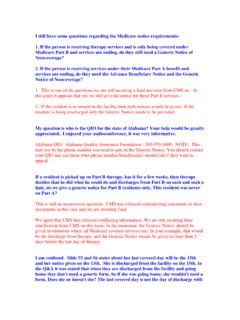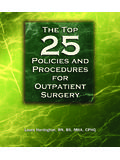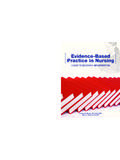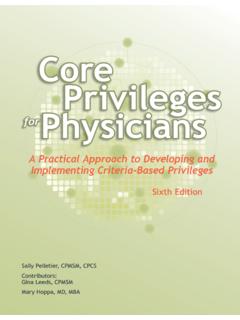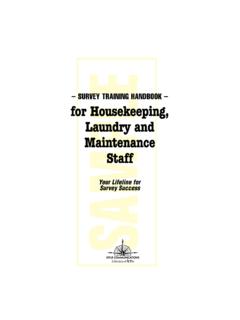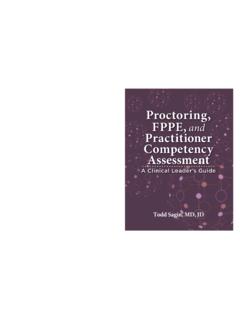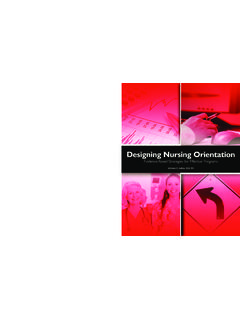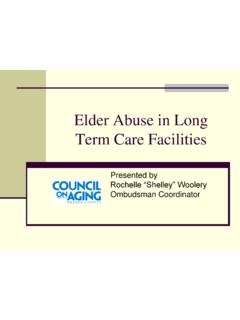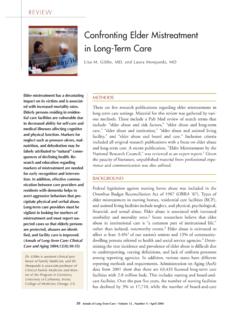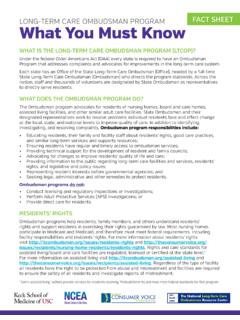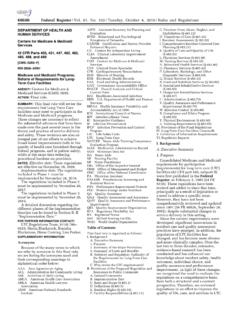Transcription of The Long-Term Care Mock Survey Toolkit
1 The Long-Term care mock Survey ToolkitA Step-by-Step Guide to Survey Readiness by Rhonda DePaul, RN, BS, MPMThe only sure-fire way to prepare for your unannounced state Survey is to put your facility through the paces of a realistic mock Survey . That s why HCPro is proud to present The Long-Term care mock Survey Toolkit : A Step-by-Step Guide to Survey Readiness, a first-of-its-kind resource that takes your facility through every step of a state Survey . Additional HCPro titles to add to your library: Survey Prep Training Kit for Frontline Staff Long-Term care Risk Management: Pressure Ulcers Long-Term care Risk Management: Resident Falls Quality Indicators: A Practical Guide to Assessment and Documentation Survey Troubleshooter: Proven Strategies for Mastering the Top 25 Nursing Home DeficienciesAbout HCPro, , Inc., is the premier publisher of information and training resources for the healthcare community. Our line of products includes newsletters, books, audioconferences, training handbooks, videos, online learning courses, and professional consulting seminars for specialists in health information management, compliance, accreditation, quality and patient safety, nursing, pharmaceuticals, medical staff, credentialing, Long-Term care , physician practice, infection control, and safety.
2 Visit the Healthcare Marketplace at for information on any of our products, or to sign up for one or more of our free online e-zines. Rev. 6/2005 Box 1168 Marblehead, MA 01945 The Long-Term care mock Survey Toolkit : A Step-by-Step Guide to Survey Readiness DePaul HCProRhonda DePaul, RN, BS, MPMR honda DePaul, RN, BS, MPM, is a nurse consultant with over 18 years of experience in the healthcare arena, ranging from acute care , home care , and Long-Term care . Rhonda holds a Bachelor s Degree in Human Resource Management and a Master s Degree in Public Management with a specialty in Health Services Administration. She has exten-sive experience in managing Long-Term care Department of Health surveys and acute- care JCAHO surveys. Rhonda also has extensive experience in development of case management programs for Medicare and Medicaid Managed care recipients that include oversight to ensure regulatory compliance in both clinical and reimbursement processes.
3 She has written and lectured on the effects of patient-focused care and the CMS Quality Indicators. Th e Lo n g- Te r m Ca r e mo C k Su r v e y To oL k iTAbout the author ..vSection One: The purpose of the mock Survey ..1 Introduction to Medicare and Medicaid requirements ..3 Section Two: How to begin the mock Survey ..17 Introduction ..19 Section Three: Task 1: Off-site Survey preparation ..21 Section Four: Task 2: Entrance conference/on-site preparatory activities ..27 Section Five: Task 3: The initial tour ..31 The tour ..33 Phase 1: Preselected concerns and potential residents ..34 Section Six: Task 4: Sample selection ..37 Key definitions ..39 Phase 1 sample ..39 Phase 2 sample ..41 Other Phase 2 tasks ..42 Section Seven: Task 5: Information gathering ..45 General observations of the facility ..47 Kitchen/food service observations ..48 Resident review ..48 Investigative protocols ..51 Hydration protocol ..56 Dining and food service protocol ..59 Contents Th e Lo n g- Te r m Ca r e mo C k Su r v e y To oL k iTCo nT e nT SSufficient staffing investigative protocol.
4 62 Closed record reviews ..62 Hospice care review ..63 Dialysis service review ..63 Quality-of-life assessment ..64 Quality of care ..65 Medication pass ..65 Quality assessment and assurance review ..66 Abuse prohibition investigative protocol ..67 Section Eight: Task 6: Informational analysis for deficiency determination ..69 Deficiencycategorizaton ..72 Section Nine: Task 7: Exit conference ..75 Key considersations during an exit conference ..77 Appendix A: mock Survey forms ..79 Appendix B: Additional forms ..201S e c t i o n O n eThe purpose of the mock Survey Th e Lo n g- Te r m Ca r e mo C k Su r v e y To oL k iTTh e p u r p oS e o f T h e m oC k S u r v e yIn today s regulated Long-Term care environment, nursing home care providers must become proactive in their strategies for Survey preparation. As you work through and use the tools provided in this manual, your facility will enhance ownership of the Survey process and become better equipped to drive your facil-ity toward improved outcomes and Survey manual can help all levels of staff participate in an in-house Survey .
5 It will help them understand Long-Term care Survey regulations and interpretive guidelines, and it will empower them to approach an upcom-ing Survey with confidence by making them aware of and educating them about the Survey process. The manual also helps the facility administrator, the director of nursing, and other managers analyze current clinical and operational systems and promotes collaborative learning for staff at all levels. Facilities should be in Survey -readiness mode all the time. The tools provided in this manual will capture clinical and operational system outliers and will allow your facility s administration to visualize and ana-lyze in-house processes on a daily basis so they can avoid unnecessary resident incidents and effectively capture information about residents at risk for negative outcomes. As professionals working in Long-Term care , we are all reminded daily of the highly regulated world in which we live. We also are committed to caring for our aging population and understand the multi-fac-eted dynamics of rendering care to those who need skilled nursing.
6 For example, one challenge for us is to address the needs and desires of family members, who often are left with unanswered questions or inadequate understanding of the levels of dependence that their loved ones require. Performing your own in-house mock Survey can help you identify such needs. Allow this process to be collaborative and interdisciplinary so that all staff involved will learn Survey regulations and the Survey begin! Introduction to Medicare and Medicaid requirementsSkilled nursing facilities and nursing facilities must comply with both 42 CFR Part 483 and Subpart B to receive payment under the Medicare and Medicaid programs. These can be found in Centers for Medicare & Medicaid Services (CMS) State Operations Manual under Section To obtain certification, a skilled nursing facility or nursing facility must comply with the Life Safety Code and complete a standard Survey . Th e Lo n g- Te r m Ca r e mo C k Su r v e y To oL k iTSe C Ti o n o n eCMS forms 671, 672, 673, and 677 (Figures , , , and in Appendix A) must be completed and presented to the Survey team.
7 The overall success of your Survey will depend on your facility s ability to demonstrate compliance with 42 CFR 483. The following subtitles will help you understand what surveyors typically look for, including resi-dent rights, quality of life, resident assessment, quality of care , and other services related to your facility s operations. The author has provided many audit tools for these requirements that can help your facility determine whether it is in compliance with the regulations. These areas are mandated by law and expected to be in rightsTo demonstrate compliance with 42 CFR , a facility must be able to demonstrate resident rights. Upon admission, all residents must be notified of their rights both orally and in writing. See Figure in Appendix A for a ensure compliance with the law, a nursing facility must check that it notifies residents about their resident council meetings to review resident rights information and to keep residents informed of their rights during their nursing facility stay.
8 The resident council meeting minutes must be protected to ensure resident confidentiality and should indicate that resident complaints are followed up over a reason-able time , transfer, and discharge rightsTo comply with regulation , the facility must permit each resident to remain in the facility and not be transferred. The facility cannot discharge residents unless their welfare is in jeopardy or their needs cannot be met. Exceptions can be made when health conditions of the resident or of other residents are at risk because safety concerns are present. When a resident is unable to pay for services after reasonable and appropriate notice, or because the facility closes. Some other resident discharge concerns include the following: Nursing facilities must provide documentation when a resident discharges or transfers under any cir-cumstances. This documentation must be available in the resident s physician discharge or transfer summary. Documentation also must be available to validate that the resident/family was notified at least 30 days prior to transfer or discharge.
9 Th e Lo n g- Te r m Ca r e mo C k Su r v e y To oL k iT Exceptions will be made if the resident is a safety risk to other individuals in the facility, or when there is an improvement or decline in the resident s condition. Special considerations apply for residents with developmental disabilities and who are mentally ill. Pay special attention to 42 CFR in these cases. Nursing facilities should obtain the regulations and become familiar with their state- specific laws to ascertain compliance. Prior to transfer, a nursing facility must provide to both the resident and a family member written information that specifies the duration of the facility s bed-hold policy. The facility must maintain identical policies and practices regarding transfer, discharge, and provision of services under the state plan for all individuals, regardless of source of payment. Nursing facilities are expected to know the law and state regulations related to nursing facility payment sources. Facilities must never request that residents waive their rights to Medicare or Medicaid.
10 Facilities also are not permitted to require a third-party guarantee of payment to the facility as a condition of admission. When residents stay at the facility under a Medicaid payment structure, the facility is not permitted to charge, solicit, or accept any amount other than that required to be paid under the respective state s plan. However, the facility may charge a Medicaid resident for items and services the resident has requested and received that are not covered by Medicaid, as long as the facility gives proper notice and information about cost of the services. This information should be given to the resident/family during the admissions process as part of the admissions agreement. Resident behavior and facility practices42 CFR specifically states that the resident has the right to be free from any physical or chemical restraint and free from physical, verbal, sexual, and mental abuse. Facilities must provide a safe environ-ment for their residents, as evidenced by developed policies and procedures that prohibit mistreatment, neglect, and abuse of residents and misappropriation of resident property.
